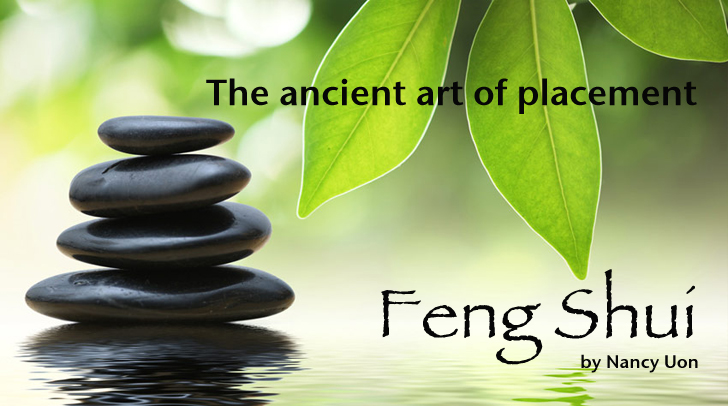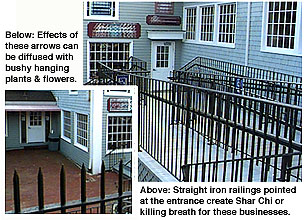

Since my last article I've received many e-mails with questions about the practice of Feng Shui. "Do I need to follow a certain school of Feng Shui? I've heard that unless you practice 'pure' Feng Shui, whatever you do is a sham. Is this true? Do I have to learn about 'I Ching' to use Feng Shui?"
Since the practice of Feng Shui has been around for many, many centuries, various schools have arisen. The most prominent among modern practitioners are the Compass School, which places more stress on metaphysical speculation, along with I Ching, Pa Kua and Lo Shu square, and the Form School, which places focus on dragon symbolism and land formation. The material offered in these articles is drawn from both schools.
To practice Feng Shui on a personal, amateur level, one only needs to understand the basic principles and key concepts. I feel that any steps a person takes to make himself more aware of his relationship to his evironment, and vice versa, can only result in positive growth and benefits.
The first key concept one needs to understand is Chi, the living energy that flows through all things in the physical world. Every physical thing, buildings, rocks, plants and land carry their own Chi qualities. Chi is the vital energy that connects and moves everything.
Your business entrance is vital to your success
This concept of Feng Shui deals with harnessing auspicious energy or "Cosmic breath" (Sheng Chi) and avoiding contact with inauspicious energy or "killing breath" (Shar Chi). Auspicious energy lines travel in a meandering or wandering pattern. Killing breath is created by straight lines, sharp pointed objects or structures and pathways that channel this negative energy. This effect comes into play indoors and out, at work and at home. Persons or places that are hit or attacked by this vicious killing breath, described as "poison arrows" can suffer ill fortune, health and other negative effects.
 Poison arrow structures can be sharp corners, pointed roof angles, tall building, electrical towers, crosses or overhead beams. The negative energy that emanates from poison arrows travels in straight lines. The sharper and more threatening the poison arrow, the more intense the consequences of being hit. Misfortunes suffered by the hit may take the form of illness, monetary loss, legal problems or missed opportunity. Being aware of these arrows allows one to avoid them completely. If that is not possible, there are many methods used by the various schools of Feng Shui to counteract these ill effects.
Poison arrow structures can be sharp corners, pointed roof angles, tall building, electrical towers, crosses or overhead beams. The negative energy that emanates from poison arrows travels in straight lines. The sharper and more threatening the poison arrow, the more intense the consequences of being hit. Misfortunes suffered by the hit may take the form of illness, monetary loss, legal problems or missed opportunity. Being aware of these arrows allows one to avoid them completely. If that is not possible, there are many methods used by the various schools of Feng Shui to counteract these ill effects.
The Threshold is the "mouth" where Chi enters
Since the threshold or main door of your residence is considered to be "mouth" through which Chi enters, it must be protected against poison arrows which create bad Shar Chi energy. A steep, angled roof facing your front door is the most common form of poison arrow. Telephone poless or tall street lights and spire shapes are also threats. A very tall tree with a massive trunk can be another. If you are undertaking new construction, these problems can be remedied by changing the angle of the door. If you are dealing with pre-existing property, a screen of tall trees or foliage can block these arrows.
Feng Shui & mirrors
I recently read about a local woman who witnessed many automobile accidents outside her home. After learining about Feng Shui she discovered that a structure a few houses down creating a poison arrow which pointed directly at the spot in which the accidents happened. She placed a mirror in front of her house and found that the accidents began to occur further down the street.
Indoors, all rooms have corners, beams and columns that can act in the same way, creating poison arrows which need to be countered. Overhead, exposed beams are also considered a hindrance to growth and wealth. Exposed beams are thought to bring oppressive Chi and breed distrust and dishonesty. Unfortunately, many buildings and homes today have these components.
There are several remedies that can be used indoors. For protruding corners or columns, soften the edges with cascading, crawling, or tree-like plants. This will serve to diffuse the negative effect. Covering columns with mirrors from top to bottom causes the column to disappear. Adding plants and light to corners engourages Chi to circulate. By purchasing furnishings or creating space with rounded edges you can avoid the creation of negative energy.
Wind chimes placed in front of sharp edges can also be effective. The chimes should be the type with hollow rods, forcing Chi to rise through the rods, while the tinkling sound of the chime causes the Chi to be auspicious.
In the case of exposed, overhead beams, hang two bamboo flutes facing each other from the beam. The flutes should be tilted upward to draw the Chi in the same way as the chimes. Tie some red threads around the low end of the flutes.
Take this new information, and with fresh eyes, survey your living and work space. You will find that there are reasons for the discomfort that you feel in certain surroundings. Once you have cancelled these effects in your environment you can begin to create areas where positive energy or Sheng Chi will linger. We will deal with this in the next article.
Many readers have inquired whether I have a book available or hold seminars about Feng Shui. I do not have plans for either and have chosen to share information with ViewZone readers through occasional contributions.
If you are interested in learning more about Feng Shui, take a trip to your local bookstore. Feng Shui is gaining popularity rapidly in the U.S., and a number of good publications are now on the market.
This is a three part article on Feng Shui. Nancy Uon is an interior designer, specializing in corporate settings in New York. She recently relocated to Litchfield County in Connecticut.
